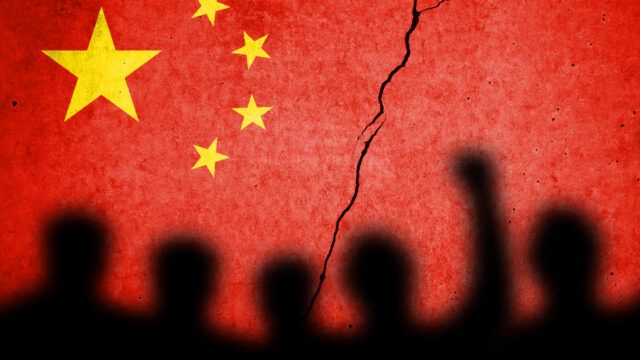After a disastrous three years, investors want clear direction from China policy makers. Most importantly, they need to see that Beijing is tackling a host of fundamental problems.
These include the country’s protracted property crisis, the massive accumulation of local government debt, the deflationary pressures that indicate the apparent shift to consumer-driven growth is failing and China’s aging population.
The CSI 300 index, which measures the top 300 companies on the Shanghai and Shenzhen stock exchanges, has plunged 44% (in US dollar terms) during the past three years and Hong Kong’s Heng Seng index (HIS) — which also lists the shares of major China companies — fell around 40% in the same period, according to FE fundinfo data.
In contrast, the MSCI World index posted a positive 23% return, and the S&P 500 soared 32.7%. Last year alone, the CSI 300 and the HIS lost 10.9% and 13.8% respectively, while investors turned to a renascent Japan, whose market was up 20.8% and to the alternative emerging giant, India, where the MSCI India index surged 21.3%, according to FE fundinfo.
Indeed, “a positive outlook for India is further reinforced by weakening investor confidence in China, which puts India in a favourable position as a viable alternative to China in the eyes of global investors. For China, we remain on the sidelines, as we wait for the bottoming process to unfold,” Bhaskar Laxminarayan, CIO and head investment management Asia, Bank Julius Baer told a media roundtable in Hong Kong
Yet, dozens of funds available to Hong Kong and Singapore retail investors with a broader Asia Pacific ex Japan mandate also suffered because China stocks comprise 31% and Hong Kong 5.8% of the MSCI benchmark, which excludes Japan and allocates only 20% to India.
The index generated an unimpressive 7.7%, while the average return by mutual funds benchmarked to the MSCI Asia ex Japan was a dire 3.6%. Asian investors would have been far better buying units in an average US equity fund and reaped a 25.6% return last year – or simply placed their cash in time deposits.
Contrarians take tentative steps
However, for some investors, this provides an opportunity.
“We are actively seeking smarter growth in Asia, focusing on our highest conviction position in buying Hong Kong and China equities amid negative market sentiment,” Michael Dyer, investment director, multi-asset at M&G Investments, told a Hong Kong media briefing.
“China, with its determined policy stance, is as a potential dark horse, particularly in efforts to stabilise the real estate sector. We anticipate further measures and a turnaround in sentiment, making it a candidate for positive surprises,” his colleague, Guan Yi Low, head of fixed income Apac said.
Wei Li, multi-asset quant solutions portfolio manager at BNP Paribas Asset Management, says that China represents is a “dream market for alpha generation that investors choose to ignore at their peril”. “Investors should look beyond the beta of the benchmarks, and find performance from stock-picking.”
Moreover, “it is too risky to short or underweight Chinese stocks due to their cheap valuations,” according to Stefan Hofer, chief investment strategist at LGT Bank Asia.
There are still very profitable Chinese companies in sectors ranging from technology to tourism that are trading at a “huge discount” relative to global stocks, he told a recent media briefing in Hong Kong.
On a comparative basis, that is certainly true. The price-earnings ratio (PER) of China Shanghai stock exchange is around 11.6 and on the Hang Seng about 9.5, according to data from the exchanges, which is well below the multiples of the S&P 500 (23.7), Japan (20.7) and India’s SENSEX (24.4).
More cautiously, UOB Asset Management is “constructive on Asia” with Asia’s growth turning firmer in the second half of the year, contingent on a policy-driven recovery in China’s growth.
It has an overweight position in Hong Kong, with private consumption strength and continued momentum in inbound tourism likely to sustain economic recovery, it says, but it remains sceptical about China’s near-term prospects.
More than $6trn has been wiped out from the market value of Chinese and Hong Kong stocks since 2021, and the CSI 300 Index hit a five-year low in late January. Gross domestic product officially grew 5.2% in 2023 – the weakest performance in decades, excluding the two years of the pandemic, when Beijing’s imposed some of the world’s toughest pandemic restrictions.
Short-term rescue
Recently, the bulls were encouraged – albeit briefly. Reports of a $278bn rescue package for the stock market lifted shares for a day on 23 January.
A similar rescue plan was arranged for China’s stock market in 2015 which, although it stemmed the rout in share prices, also included measures, such as restricting share sales, which presaged Beijing’s later capricious interventions in corporate China. These included tightening regulation of tech giants such as Alibaba and Tencent, the temporary disappearance of company chief executives, and most notoriously, the overnight ban on the multi-million-dollar private tutoring industry.
Meanwhile, Hong Kong’s self-autonomy has continued to erode since the imposition of a national security law in 2020, and the relentless pursuit of participants in widely popular 2019 protests. There are fears now that Hong Kong’s much vaunted legal independence might be threatened by a new ordinance allowing the enforcement of mainland Chinese court orders in civil cases in Hong Kong.
Perhaps, China stocks are ready for a correction, However, it is likely that broader structural reforms and reassurance over governance issues are needed to restore investor confidence.

















